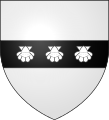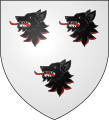|
Argent
In heraldry, argent (/ˈɑːrdʒənt/) is the tincture of silver, and belongs to the class of light tinctures called "metals". It is very frequently depicted as white and usually considered interchangeable with it. In engravings and line drawings, regions to be tinctured argent are either left blank, or indicated with the abbreviation ar. The name derives from Latin argentum, translated as "silver" or "white metal". The word argent had the same meaning in Old French blazon, whence it passed into the English language. In some historical depictions of coats of arms, a kind of silver leaf was applied to those parts of the device that were argent. Over time, the silver content of these depictions has tarnished and darkened. As a result, it can sometimes be difficult to distinguish regions that were intended as "argent" from those that were "sable". This leaves a false impression that the rule of tincture has been violated in cases where, when applied next to a dark colour, argent now appears to be sable due to tarnish. Argent versus whiteArthur Charles Fox-Davies argued in his book The Art of Heraldry that, though extremely rare, the colour white existed as an independent tincture in heraldry separate from argent. He bases this in part on the "white labels" used to differentiate the arms of members of the British royal family. However, it has been argued that these could be regarded as "white labels proper", thus rendering white not a heraldic tincture.[1] Poetic meaningThe different tinctures are traditionally associated with particular heavenly bodies, precious stones, virtues, and flowers, although these associations have been mostly disregarded by serious heraldists.[2] In addition to the metal silver, Argent is associated with:
Gallery
ReferencesLook up argent in Wiktionary, the free dictionary.
|
||||||||||||||||||||||||




